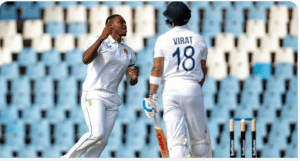Last updated on January 31st, 2022 at 10:18 am
[ad_1]
South Africa may have been placed on the back foot in the first Test in Centurion by India’s excellent opening day performance, but home side pacer Lungi Ngidi indicated on Sunday (December 26) that they can still turn the match around if they can bowl the tourists out for less than 350 runs. India rode on the duo’s century-plus opening stand to close day one on 272/3. Vice-captain KL Rahul hammered an unbeaten 122, while opening partner Mayank Agarwal produced a resolute 123-ball 60.

“You win sessions, you lose sessions in Test cricket.” Overall, it’s been an enjoyable day of cricket. There’s still a lot of work to be done on that wicket. “Things may happen rapidly,” the 25-year-old noted following the day’s events at a press conference.
South Africa took a step back after Ngidi’s 41st over double strike in consecutive balls.

“Anything can happen when you get two wickets in two balls.” And if we can make a couple of early morning breakthroughs, we might be able to turn the game around. The balls are still clipping the edge and heading for the slips… If we can maintain them under 340-350, that would be fantastic.”
Ngidi was South Africa’s only wicket-taker on the day, returning with 3/45 in 17 overs and becoming the first bowler in Test history to remove Cheteshwar Pujara for a golden duck twice. Ngidi was having trouble keeping up with the rest of the Proteas attack, but a change of ends helped him out.
“At lunch, I asked if I could trade ends, but everyone obviously prefers their preferred end, so I had to wait my turn.”
“I was simply straining a little bit on the other side to locate the appropriate regions, but as I arrived this way, I felt at ease, and things started happening for me all of a sudden,” he explained.
He stated that the home team’s bowlers were dissatisfied with the surface because it lacked seam. “The wicket didn’t perform as well as we had hoped. And they (the Indians) were disciplined and left well. I was expecting a little more swing, and when that didn’t happen, you had to adjust your strategy and attempt to get the ball off the deck, which was occurring on both ends. The strategy was to go after the stumps and the pads.”
[ad_2]




